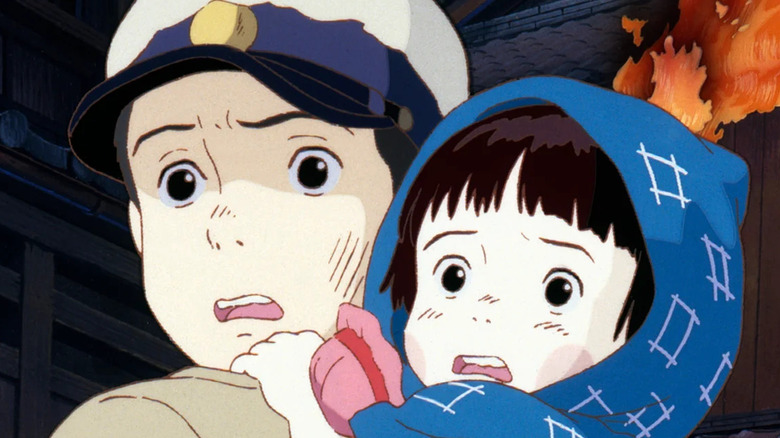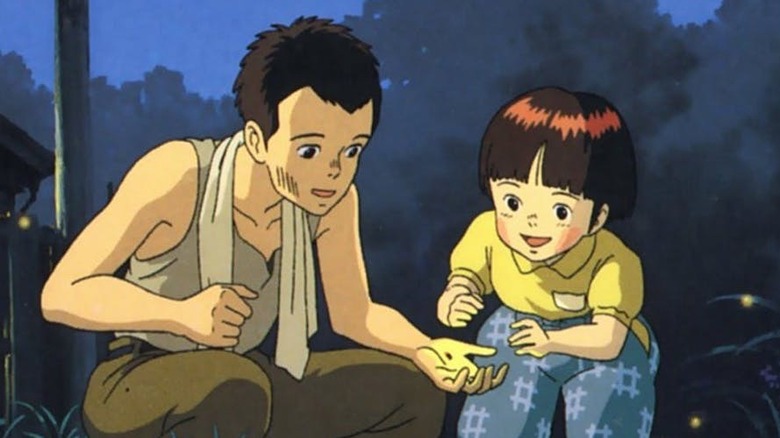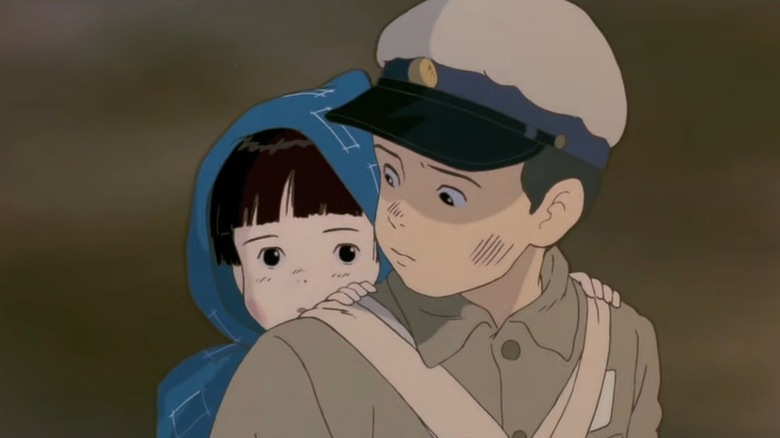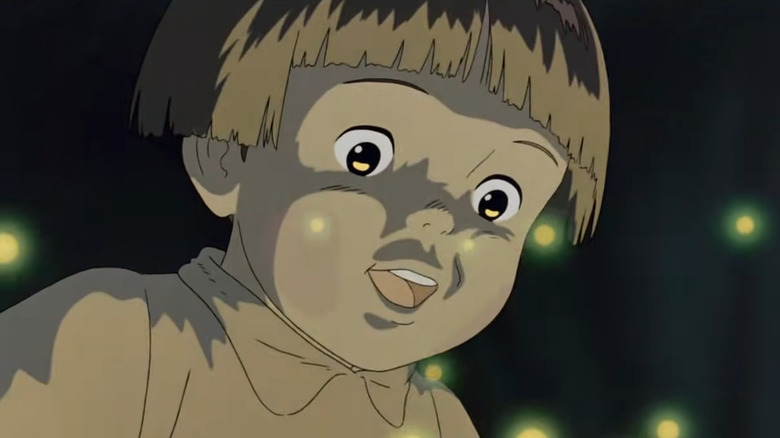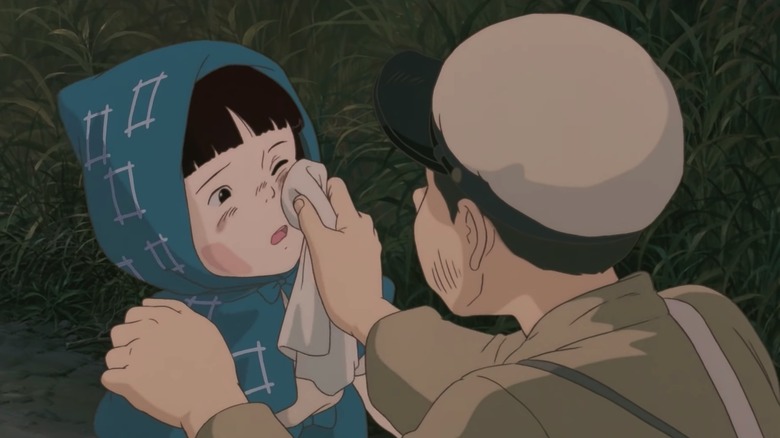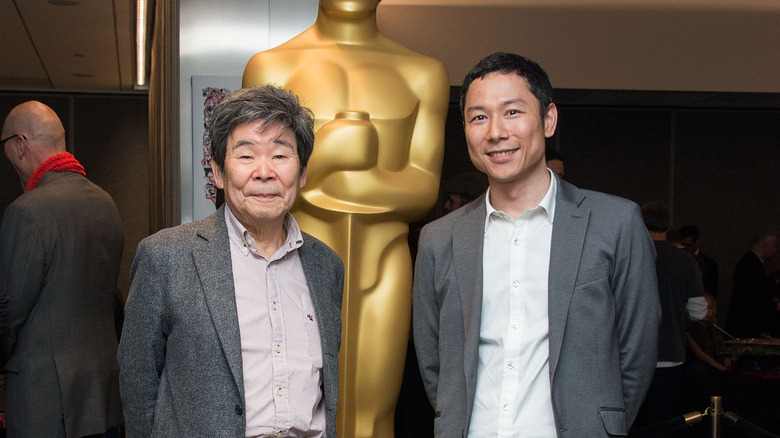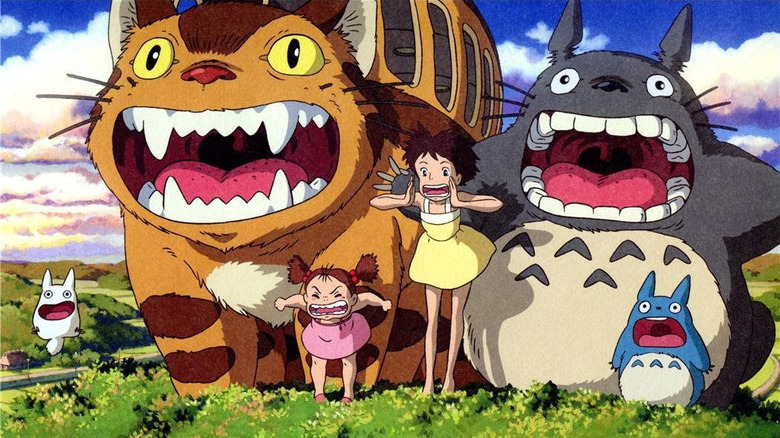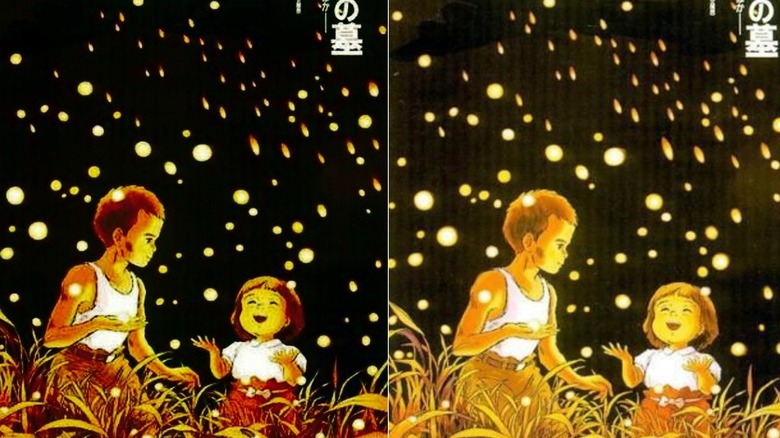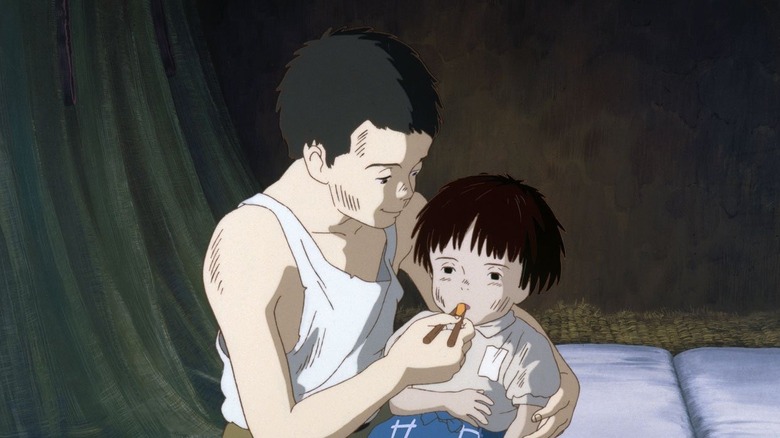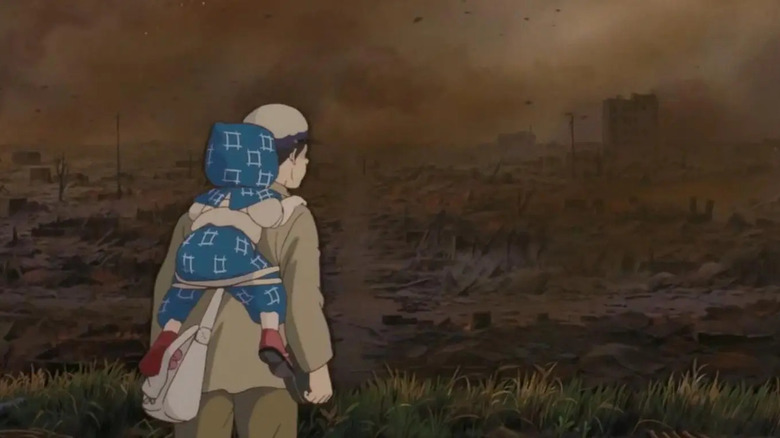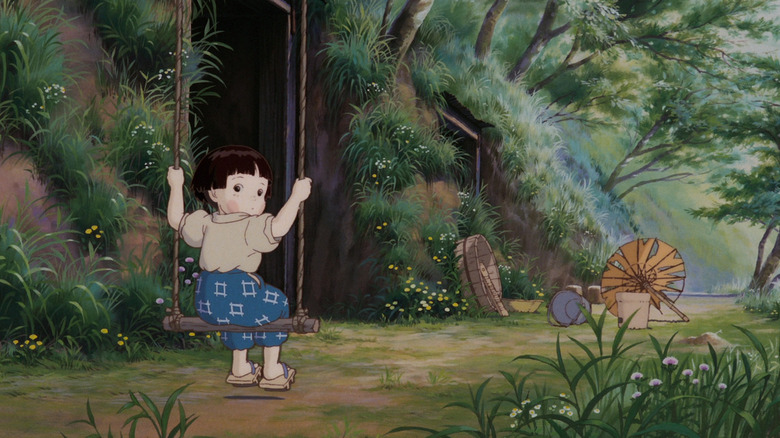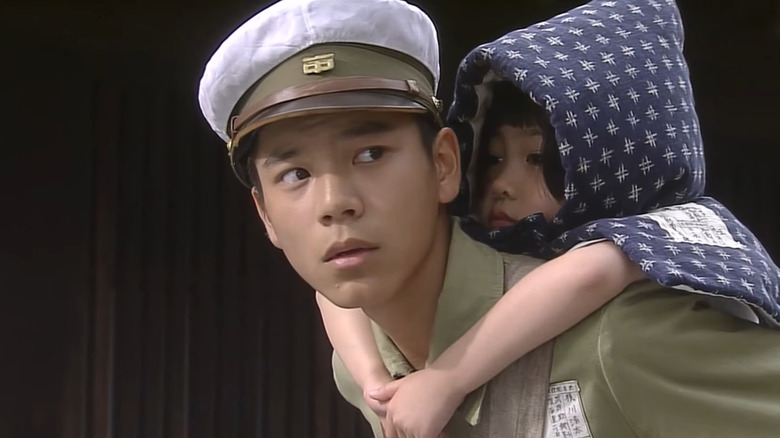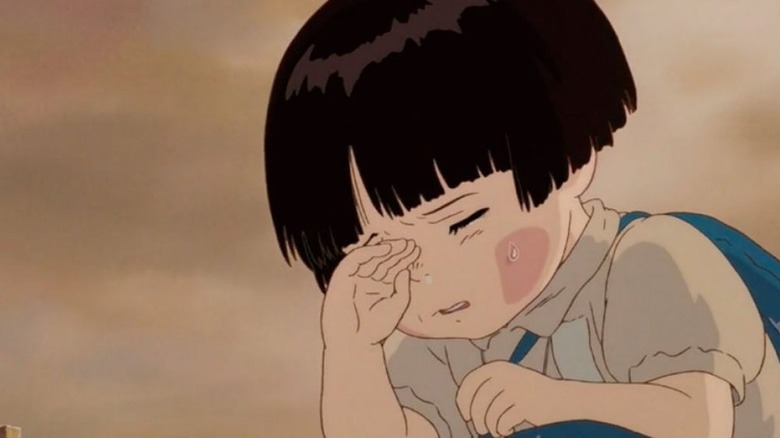The Untold Truth Of Grave Of The Fireflies
Every so often, an animated film shakes things up and shows the world what's really possible within the medium. In 1988, that film was Isao Takahata's "Grave of Fireflies," one of the first movies released by the now-revered Studio Ghibli. "Grave of Fireflies" follows 14-year-old Seita and his 4-year-old sister, Setsuko, as they attempt to survive the tail end of World War II in Kobe, Japan. It's a harrowing movie, from its foreboding start to its tragic ending, and critic Roger Ebert called it one of "the greatest war films ever made."
Prior to the release of "Grave of Fireflies," few could've imagined that an animated film depicting children could be so emotionally impactful. Today, you'd be hard-pressed to find anyone who's willingly watched the film multiple times, indicating how affecting it really is. "Grave of Fireflies" was a cinematic marvel in 1988, and it remains one today, even with all the advances in animation that have emerged since then. Nothing beats pure emotion and dazzling artistry.
If you know anything about animation, you're probably aware that animated films are a labor of love, especially when they're hand-drawn like most Studio Ghibli films are. Considering the impact the film has had on moviegoers worldwide, one would assume a lot of thought and care went into making it. If you're hoping to discover how this masterpiece came to be, then you're in the right place. Keep reading to discover everything you need to know about the making of "Grave of Fireflies."
Grave of the Fireflies is based on a novella
Though hundreds and hundreds of World War II movies have been made over the years, there are few like "Grave of Fireflies." Both the animation and the fact that it focuses on children make it quite unique within the genre. "Grave of Fireflies" wouldn't exist without its source material — the novella of the same name written by Akiyuki Nosaka. Speaking with Animerica prior to the film's release, Nosaka revealed that Isao Takahata and Studio Ghibli were far from the first filmmakers to offer to turn the book into a movie. Nosaka noted that these projects never worked out because the book seemed impossible to adapt, both because of its desolate setting and the malnourished children at its center.
Nosaka explained that he was surprised by the offer from Takahata to animate the film, as he thought animated films were meant for joyful, adventurous stories. Eventually, however, he was convinced. "I just saw a storyboard at your studio, and I realized this could only be done with animation," Nosaka told Takahata. Nosaka was especially concerned that filmmakers wouldn't be able to properly depict the backdrop of the novella. "From the rice paddies in the background to the townscape. That wouldn't be possible filming at some location in live-action," he explained. But by the time he saw Takhata's sketches for the film's setting, he was reassured that the story was in good hands.
It's based on a true story
Though most war stories are at least partially based in truth, "Grave of Fireflies" is a very personal story for author Akiyuki Nosaka. The novella from which the film was adapted is based on the true story of Nosaka's experience during the war. A young teenager during the war, Nosaka was adopted by his aunt after his mother died during childbirth. His aunt was terribly wounded by the bombs, and he never saw his father again.
However, the death that most haunted Nosaka was the death of his younger sister, who died of starvation at the age of 16 months. Nosaka spent years feeling guilty for his sister's death, thinking that he could've done more to save her. These details made their way into the book. As Nosaka told Animerica, "My sister's death is an exact match with the novel. It was one week after the end of the war."
Director Isao Takahata — who died in 2018 — had his own harrowing experiences during the war. In June 1945, Takahata's hometown of Okayama was bombed by U.S. forces. A 9-year-old Takahata was separated from his family along with his older sister, who was wounded by a bomb. Though Takahata and his sister were eventually reunited with their family several days later, Takahata would never forget those agonizing days. It's no wonder that "Grave of Fireflies" is such a powerful film considering the experiences of the writer and director. The novella from which the film was adapted is a very personal text, and one would assume Takahata's own experiences during the war influenced the film's production as well.
It was difficult to properly animate the main characters
Though Akiyuki Nosaka was confident animation was the perfect medium for adapting his book, director Isao Takahata has admitted that animating the story was no easy task. Takahata found that one of the most difficult aspects of the project was animating the main characters. "Just like today's junior high students, a 14-year-old looks unemotional or grumpy or emotionally unbalanced. It's reflected in their bodies and in their facial expressions," Takahata told Animerica. Because animation always exaggerates the expressions of characters, Takahata explained that Seita — a character who's going through puberty — was difficult to animate in a way that illustrated the nuance of his behavior.
Seita's sister, Setsuko, was even more difficult to animate, Takahata said. Prior to "Grave of Fireflies," Takahata worked on a show called "Heidi, Girl of the Alps," which followed a 5-year-old girl. Takahata initially assumed he could just depict Setsuko like he did Heidi, but then he realized that Setsuko had to look different because she was younger and also living in a very different environment than Heidi. Takahata noted that he had never really depicted "real" Japanese characters before, saying, "In Japanese animation, you're not allowed to depict Japan with much realism."
Animators used a unique coloring technique
Though "Grave of Fireflies" is often celebrated because of the emotional punch it packs, the impressive animation techniques used in the film are also worth noting. Eagle-eyed viewers may notice that something is just a little bit different with the film's coloring. Part of the film's unique style comes from the fact that the outlines are done in brown, rather than in the traditional black. Black is usually used in animation to outline images because it provides the most contrast.
Speaking with Animerica, color coordinator Michiya Hoda revealed why they made this choice. "The reason it was done in brown was to give a softer feeling to the screen," he explained, going on to say, "It was a technique unused in anime up until that point, and it was done as a challenge." It was difficult to work with brown in this way because it doesn't provide contrast in the same way that a black outline does. There were a few cases where a black outline was a necessity, but animators worked to limit their use of black whenever they could. Details like these may not seem like a big deal, but each small design element adds up to a rather astounding final product.
A planned follow-up was never made
"Grave of Fireflies" might not seem like the type of film that warrants a sequel, but director Isao Takahata once had a plan to make a film that was in many ways a follow-up (or more literally, a predecessor) to his famous tearjerker. According to Little White Lies, the project was entitled "Border 1939," and it was meant to depict the beginning of World War II in Japan, while "Grave of Fireflies" is set during its conclusion.
In his outline for the film, Takahata described the setting as 1930s Seoul, under the control of the Japanese. The story would revolve around Akio, a Japanese student going to school there. When he discovers that his friend is still alive despite reports of his death, Akio travels to Manchuria to find him, learning that his friend is part of the anti-Japanese resistance there. As a means to prove himself to the resistance fighters who've taken him in, Akio volunteers to escort a woman back to her homeland.
"Border 1939" stands out from Takahata's other films in its vast scale and epic, thoroughly heroic story. Takahata was clear about his intentions for the film, which were as follows — to prove the "real world" is an appealing setting for anime films, to educate Japanese youths about their country's ugly history, and to inspire viewers to question how they build their sense of identity. Though "Grave of Fireflies" certainly has some anti-nationalist impulses, many viewers see it as a tragic, self-contained story about family, rather than an explicitly political work. Had "Border 1939" been made, it likely would have explored these political questions more explicitly.
Grave of the Fireflies was released as a double-feature with My Neighbor Totoro
One of the most surprising facts about "Grave of Fireflies" has to do with the nature of its release. You may be surprised to know that "Grave of Fireflies" was actually billed as a double feature with Hayao Miyazaki's beloved "My Neighbor Totoro" upon its initial premiere in 1988. One can only imagine the shock audience members must've experienced as they watched the two films back to back, and we wouldn't be surprised if the double billing turned some viewers off from the film altogether.
The pairing of the two films might seem like a strange choice, but Alex Dudok de Wit, the author of a book on "Grave of Fireflies," argues that they actually have a lot in common. "They are interested in so many of the same things — death, the beauty of nature, recent Japanese history, the gray area between childhood and maturity — and sometimes feel like mirror images of each other, one light, one dark," he said in an interview with Lost in Anime.
Though the double billing has been called a "terrible idea," both films have remained popular to this day, so it doesn't seem to have hurt the reputation of either movie. Indeed, Nerdist has said, "They're the most similar movies Miyazaki and Takahata would ever make," and their release would mark the start of an incredible run of films from Studio Ghibli and the beginning of their worldwide acclaim.
The original poster hides a dark secret
"Grave of Fireflies" is obviously a very dark film. Even the title reveals as much, giving us an indication that what we're about to watch is nothing less than the death of innocence. The film's poster is slightly more deceptive. When you first look at it, it appears to depict the two siblings, Seita and Setsuko, playing in a field lit up by fireflies. Setsuko is smiling and holding her hands out, as if to catch them. It's a rare moment of joy, as much of the film depicts Seita and Setsuko's slow starvation and eventual death.
But, as some observant fans have noted, there's actually more to the poster than meets the eye. As JamesJSChai wrote on Twitter, "When you turn brightness all the way up, you'll see a B-29 bombing plane in the sky. What was thought as miracle lights of fireflies were really a rain of explosives." Though it's a devastating realization, it perfectly mirrors the central premise of the film. "Grave of Fireflies" is a film about the loss of innocence and the happy futures of children that are forever deferred. This jarring juxtaposition between childhood innocence and the ravages of war defines the film, and, as we've just learned, is dramatically illustrated in the film's poster as well.
The opening is meant to lessen the pain of the ending
The opening line of "Grave of Fireflies" pulls no punches. "In 1945, on the night of September 21, I died," Seita tells the audience. It's a rather shocking way to begin a film, and it has the effect of warning audiences about the tragedy that's to come. According to director Isao Takahata, the film's opening scene — which depicts Seita dying and reuniting with Setsuko — is an act of mercy on behalf of the audience. Takahata decided to draw from a common dramatic structure in Japanese films, that of the double suicide. These films often begin with the revelation that the double suicide occurred and then return to the early, happier days in a couple's life, illustrating how they got to that dark place by the end.
Speaking with Japan Times, Takahata noted that it can be deeply upsetting to watch two people descend into death and despair without warning. As such, he revealed the film's ending at the start in order to make it easier for audiences to stomach. "If an audience knows at the beginning of the film that the two will eventually die, they are more prepared to watch the film in the first place. I try to lessen an audience's pain by revealing everything at the beginning," he explained. If you've seen the film, you know that the pain that comes from watching it is very real, and it's hard to imagine how much sadder it could've been had we not known what was coming all along.
If you or anyone you know is having suicidal thoughts, please call the National Suicide Prevention Lifeline by dialing 988 or by calling 1-800-273-TALK (8255).
The director says it's not an anti-war film
Viewers of "Grave of Fireflies" have long attached various political messages to the film. But despite how audiences have interpreted it over the years, director Isao Takahata maintained that "Grave of Fireflies" isn't an anti-war film. One of the reasons Takahata made this claim was because he felt strongly that his film isn't didactic in nature.
Moreover, though Takahata may have had his own views about war, he wasn't under any illusions about his film's ability to change the world. Speaking with Japan Times in 2015, Takahata noted that the act of discussing war isn't enough to prevent war, as those who believe Japan needs a stronger military always have a seat at the table. Though he believed strongly that the atrocities of the war should never be forgotten, he nonetheless maintained, "'Grave of the Fireflies' isn't an anti-war film simply because it cannot prevent another war from happening."
It may seem like a cynical appraisal of the situation, but Takahata's own political activity at the time — opposing a revision to the Japan's anti-militaristic constitution — indicates that he wasn't willing to go down without a fight.
The film was released before it was finished
It may not come as a surprise to you that "Grave of Fireflies" director Isao Takahata was a perfectionist, especially considering the Herculean effort it takes to complete an animated film and the attention to detail such projects demand. And this perfectionism almost majorly backfired. According to Alex Dudok De Wit (via Cartoon Brew), who wrote a book on the film, Takahata was only given 14 months to make the movie. Due to his tendency for detailed historical research and the pressures he put on his staff for incredibly high-quality animation, the delays began to pile up.
As a result, "Grave of Fireflies" was unfinished upon its release. In fact, there were even some moments that were left uncolored as it entered the theaters. The film's messy release had a negative effect on Takahata's reputation as a filmmaker. The director went a really long time without work as a result, but he got a second chance when he returned to Studio Ghibli with 1991's "Only Yesterday," which was produced by Ghibli co-founder Hayao Miyazaki.
There are two live-action Grave of the Fireflies films
Despite all of the problems it had even getting into theaters, "Grave of Fireflies" remains both an influential war film and an influential animated film. However, there are actually two live-action versions of "Grave of Fireflies" — a 2005 TV movie and a 2008 film that was released in theaters. According to animation scholar Alex Dudok De Wit (via Carton Brew), the two films are technically new adaptations of Akiyuki Nosaka's novella rather than remakes, but the shadow of the original movie looms large nevertheless.
As Dudok De Wit notes, both films suffered from small budgets, which impacted moments meant to highlight the horrors of war. Plus, Dudok De Wit points out that it's much harder to make a real kid look like they're starving, which is something Nosaka had worried about when receiving offers to adapt the film. It's difficult to compete with a film as critically acclaimed as Takahata's, so we're not really sure why these adaptations were made in the first place.
The director's intention wasn't to make audiences cry
In his book on the film, author Alex Dudok De Wit noted that director Isao Takahata's intentions for "Grave of Fireflies" didn't always line up with how audiences perceived the film. Viewers of the movie often note how sad it is and how much it made them cry. While for some filmmakers, these expressions of extreme emotion are taken as a complement to the film's overall power, Takahata wasn't in it for the tears.
According to Dudok De Wit, Takahata was more interested in making viewers think than he was in making them cry. "He didn't want his viewers to cry so much as to engage in the sort of self-reflection he found lacking in contemporary Japan," Dudok De Wit writes. But most viewers found the film to be one that inspired them to feel, rather than to think. "By and large, the audience preferred to cry," Dudok De Wit explains, describing the plethora of reviews that chronicle its tear-jerking nature.
While Takahata may have considered the film a failure in this regard, its lasting influence is notable, as are the countless discussions it's surely induced. And who's to say a bit of cathartic crying doesn't have the power to change the world?
